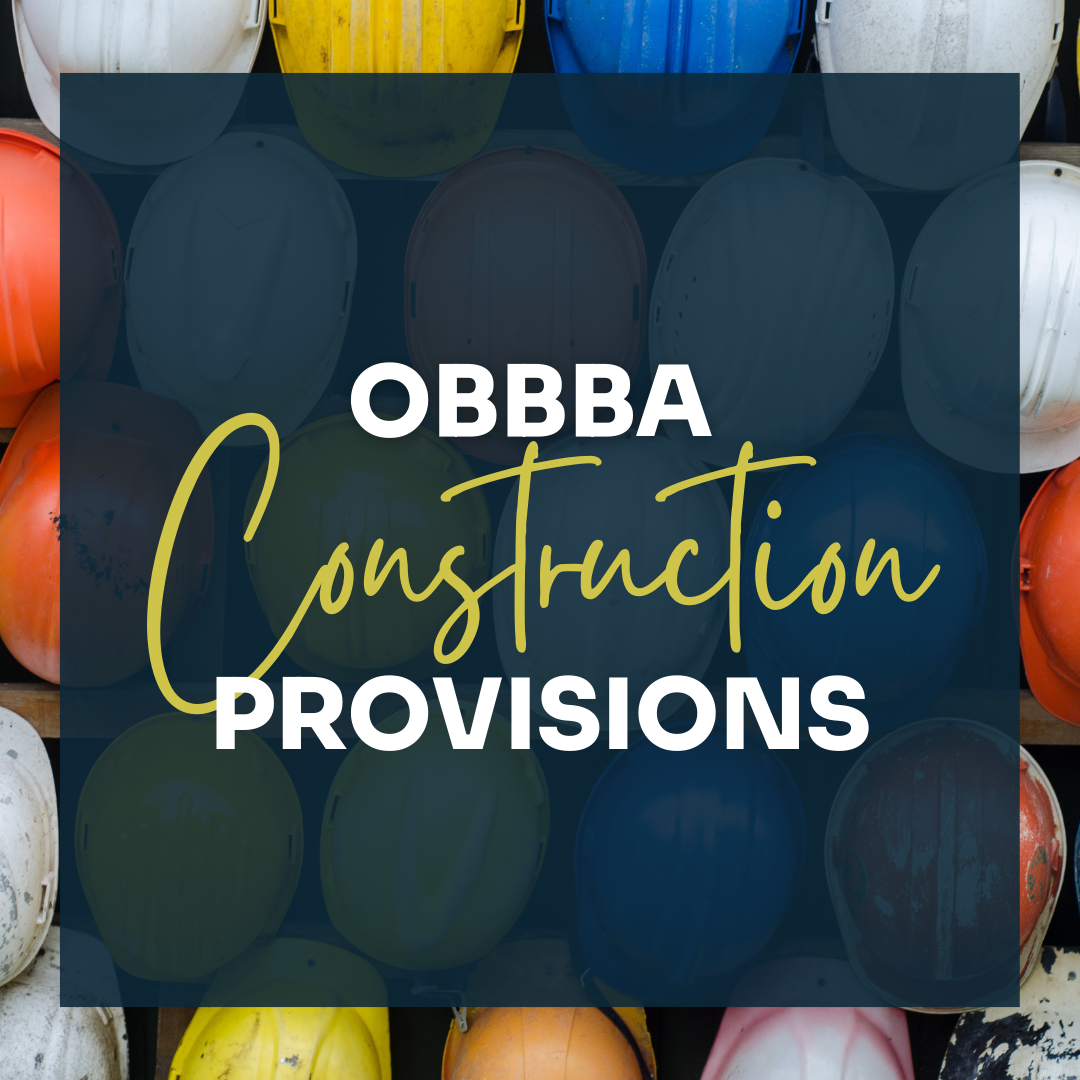It’s been about a month since the One, Big, Beautiful Bill Act (OBBBA) was signed into law. Now that the dust has settled, construction business owners and their leadership teams can begin to really pinpoint the provisions most pertinent to their operations. Here are six to study up on.
1. Exception to Percentage-of-Completion Method for Certain Residential Construction Contracts
Prior to OBBB, home construction contracts that were for buildings with four or fewer dwelling units were allowed to use more favorable accounting methods, such as the completed-contract method instead of the percentage-of-completion method (PCM). Using completed contract method over PCM allows builders to defer revenue recognition until the homes were completed. Under the OBBB, the exception now includes residential contracts involving more than four dwelling units, such as condominium complexes and multi-unit residential buildings.
For tax years beginning on or after July 4, 2025, contracts entered into for residential construction projects, per the amended definition under the OBBBA, generally qualify for an exception to the percentage-of-completion method of accounting.
That means, if eligible, you can use the completed-contract method (CCM) or other permissible methods. Under the CCM, for example, you can defer income until a project is substantially completed, which provides significant tax planning flexibility and generally improves cash flow.
2. Accelerated depreciation
The OBBBA includes multiple provisions that will allow you to accelerate depreciation on eligible capital expenditures. These breaks can also improve cash flow, as well as make new investments in equipment and machinery more viable.
The law makes permanent 100% first-year bonus depreciation for qualified new and used assets acquired and placed in service after January 19, 2025. It also increases the Section 179 expense deduction limit to $2.5 million, with the phaseout threshold raised to $4 million. The deduction is reduced dollar-for-dollar by the amount by which the cost of qualifying property exceeds $4 million. Those figures are effective for 2025, with annual inflation adjustments going forward.
In addition, the OBBB creates a temporary 100% deduction for the cost of building “qualified production property” used in manufacturing or production (e.g. factories, refineries, or production facilities). It must be used as an integral part of qualified production activity. Construction must have begun after January 19, 2025, and before January 1, 2029, and the property must be placed in service before 2031.
3. Bigger business interest deductions
If you finance capital purchases, you may be able to deduct more of the interest under the OBBBA. The business interest deduction is generally limited to 30% of your adjusted tax income (ATI). Since 2022, the deduction was limited to 30% of a business’s taxable income before interest and taxes (EBIT).
Beginning with the 2025 tax year, the OBBBA provides that ATI will again include depreciation, amortization, and depletion in the calculation. In other words, ATI will revert to being calculated based on EBITDA. This will effectively increase the ATI base, generally raising the allowable business interest deduction.
4. Distressed community construction incentives
The quality opportunity zone (QOZ) program generally allows taxpayers to defer, reduce, or exclude unrealized capital gains reinvested in qualified opportunity funds (QOFs). These funds invest in designated distressed communities across the country.
The OBBBA establishes a permanent QOZ policy that enhances the original program, which had been slated to sunset after 2026. The law also creates a new type of QOF for rural areas. Plus, the OBBBA permanently enhances the low-income housing tax credit. In sum, these programs could drive higher construction activity—including affordable housing and commercial development.
5. Reduced taxation of overtime
For tax years 2025 through 2028, the OBBBA allows employees to deduct up to $12,500 ($25,000 for joint filers) of qualified overtime pay. This tax break is available regardless of whether a taxpayer itemizes. However, it begins to phase out when an individual’s modified adjusted gross income exceeds $150,000 (or $300,000 for joint filers). The deduction is only available if the qualified overtime compensation is reported separately on Form W-2 or Form 1099.
The boost to take-home pay may make overtime more enticing to existing construction workers and job seekers considering the industry. But it also requires employers to track and report the amount of qualified overtime pay. What’s more, overtime pay will remain subject to payroll taxes and state income taxes.
6. Elimination of clean energy incentives
The OBBBA targets many of the clean energy incentives created or enhanced by the Inflation Reduction Act—including some that have spurred construction plans and projects. For instance, it eliminates the Sec. 179D energy-efficient commercial building deduction for buildings or systems on which construction begins after June 30, 2026.
The new law also eliminates the Sec. 45L new energy-efficient home credit for eligible contractors. The credit was due to expire in 2033, but it’s now available only for homes acquired on or before June 30, 2026.
7. Restoration of the R&D expense deduction
Under Tax Cut and Jobs Acts effective 2022, businesses were required to capitalize and amortize domestic R&D expenses over 5 years and foreign R&D expenses over 15 years. This change resulted in an increase in taxable income for businesses, which created a higher tax burden and potentially impacted cash flow.
The OBBBA allows you to immediately deduct domestic research and experimental expenditures paid or incurred after December 31, 2024. Foreign R&D expenses continue to be subject to capitalization and amortization over 15 years. Small businesses with average gross receipts of $31 million or less will generally be permitted to apply this change retroactively to tax years beginning after December 31, 2021, by filing an amended return. All other taxpayers may deduct the remaining unamortized domestic R&D expenses from 2022-2024 in full in the first tax year after 2024 (2025) or spread the deduction evenly over two years.
And that’s not all
To be clear, the OBBBA provisions we’ve discussed are only some of those that could affect your construction business. We can help you identify the most relevant tax-law changes and leverage the tax breaks available to your company.
© 2025


